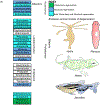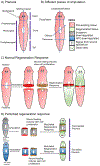Insights into regeneration tool box: An animal model approach
- PMID: 30986388
- PMCID: PMC6684456
- DOI: 10.1016/j.ydbio.2019.04.006
Insights into regeneration tool box: An animal model approach
Abstract
For ages, regeneration has intrigued countless biologists, clinicians, and biomedical engineers. In recent years, significant progress made in identification and characterization of a regeneration tool kit has helped the scientific community to understand the mechanism(s) involved in regeneration across animal kingdom. These mechanistic insights revealed that evolutionarily conserved pathways like Wnt, Notch, Hedgehog, BMP, and JAK/STAT are involved in regeneration. Furthermore, advancement in high throughput screening approaches like transcriptomic analysis followed by proteomic validations have discovered many novel genes, and regeneration specific enhancers that are specific to highly regenerative species like Hydra, Planaria, Newts, and Zebrafish. Since genetic machinery is highly conserved across the animal kingdom, it is possible to engineer these genes and regeneration specific enhancers in species with limited regeneration properties like Drosophila, and mammals. Since these models are highly versatile and genetically tractable, cross-species comparative studies can generate mechanistic insights in regeneration for animals with long gestation periods e.g. Newts. In addition, it will allow extrapolation of regenerative capabilities from highly regenerative species to animals with low regeneration potential, e.g. mammals. In future, these studies, along with advancement in tissue engineering applications, can have strong implications in the field of regenerative medicine and stem cell biology.
Keywords: Epimorphosis; Evolutionarily conserved pathways; Morphallaxis; Novel genes; Regeneration; Regulation; Tissue engineering; Wnt.
Copyright © 2019 Elsevier Inc. All rights reserved.
Figures









References
-
- An Z, Hua L, Longhua G, Xin G, Sean M, Yongfu W, Zulin Y, Jungeun P, Craig S, Eric R, Li-Chun C, Erin D, Kai L, Wei W, Anoja P, Kate H, Allison P, Andrew B, Alejandro SA, 2018. Prospectively Isolated Tetraspanin+ Neoblasts Are Adult Pluripotent Stem Cells Underlying Planaria Regeneration. Cell 173, 15. - PMC - PubMed
-
- Baguñà J, 2012. The planarian neoblast: the rambling history of its origin and some current black boxes. Int J Dev Biol 56, 18. - PubMed
Publication types
MeSH terms
Grants and funding
LinkOut - more resources
Full Text Sources
Molecular Biology Databases

